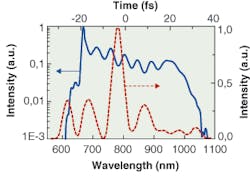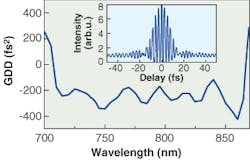GABRIEL TEMPEA AND ANDREAS STINGL
Initially driven by cutting-edge fundamental research, the development of femtosecond lasers must now respond to the specific needs of an increasing number of industrial and clinical applications. Pulse durations in the sub-7 fs range are, for instance, essential for the generation of isolated attosecond pulses via high-order harmonic generation, while compactness, stability, and user-friendliness are of paramount importance for femtosecond oscillators used in eye diagnosis via optical-coherence tomography or in nonlinear microscopy. The increasing number of diverse applications set two major trends in the development of femtosecond sources: on one hand, decreasing the routinely achievable pulse duration (eventually to less than 10 fs); and on the other, improving compactness and user-friendliness of the sources.
The Ti:sapphire laser medium has a fluorescence bandwidth that supports the direct generation of sub-10 fs pulses centered at 800 nm and exhibits excellent thermal and mechanical properties. Owing to the availability of Ti:sapphire and of spectral-broadening schemes, pulses having spectra sufficiently broad to support pulse durations below 5 fs can now be routinely generated at energies ranging from the nano- to the millijoule energy levels. The extent to which the bandwidth-limited pulse duration can be achieved critically depends on the bandwidth and accuracy of the optical components used for dispersion management.
Thin-film technology
The group velocity of light is frequency-dependent in any propagation medium other than vacuum. As a result, various frequency components of a short laser pulse experience different delays upon propagation in optical media, resulting in pulse broadening. Compensation of dispersion effects is a prerequisite for the generation and delivery of short optical pulses. With decreasing pulse duration, higher-order dispersion terms need to be compensated with increasing accuracy. The generation and distortion-free manipulation of sub-20 fs pulses calls for accurate compensation of the group-delay dispersion (GDD; the second-order derivative of the spectral phase with respect to the angular frequency) and third-order dispersion (TOD; the third-order derivative of the spectral phase with respect to the angular frequency).
Components introducing angular dispersion, like gratings or prisms, have traditionally been used to compensate for dispersion effects and recompress the pulse temporally. In this approach, the first element is used to angularly disperse the beam; the different spectral components, being now spatially resolved, experience different geometrical paths and thus different delays. A second identical element is used to compensate for the angular dispersion. An identical sequence (or reflecting the beam back on the same path) must be used to remove the spatial variation of laser frequency (spatial chirp). Lack of accuracy in the control of higher-order dispersion terms limits the use of these compressors mainly to pulses longer than 20 fs. Furthermore, grating- and prism-based compressors are large and alignment-sensitive-a major drawback, particularly for commercial laser systems (although see “Disperson compensation sharpens multiphoton microscopy,” p. 117). Owing to the large amounts of GDD they can compensate for, grating or prism pairs are, however, indispensable in chirped-pulse amplifiers.
In contrast to grating- and prism-based compressors, dispersive mirrors (DMs, also called “chirped mirrors”) allow independent engineering of GDD, TOD, and even fourth-order dispersion over bandwidths approaching one optical octave. With a compressor merely consisting of a pair of mirrors (used anyway for feedback in any laser setup), compactness and user-friendliness are dramatically improved.
Dispersive mirrors rely on the finding that the GDD introduced by dielectric multilayer reflectors can be controlled by means of the wavelength dependence of the penetration depth of the electric field.1 A mirror will introduce negative GDD (as required by most applications) if short-wavelength components are substantially reflected by the top layers while long-wavelength wave packets penetrate deeper into the multilayer structure before being reflected, experiencing a longer delay (see Fig. 1).
Despite the simplicity of the physical working principle, neither the design nor the manufacturing of DMs is trivial. Analytical predesign algorithms in conjunction with efficient numerical optimization methods have pushed DM design to their physical and technological limits, where the bandwidth and the amount of GDD are limited by the maximum number of layers and optical thickness of the coating.2, 3, 4 Recent advances in thin-film-deposition technology have resulted in dispersive mirrors with up to 90 layers that can be reproducibly manufactured with subnanometer layer-thickness accuracy.
Highly integrated oscillators
The shortest laser pulses (with durations down to 5 fs) can be generated by means of Kerr-lens modelocking in a resonator equipped with an optically pumped Ti:sapphire crystal, provided that the dispersion of the resonator is well-behaved (and close to zero) over a large fraction of the crystal’s fluorescence spectrum. Prism pairs do not fulfill this requirement, their performance being plagued by third-order dispersion. The accurate compensation of higher-order dispersion terms calls for the use of DMs in laser resonators, either in conjunction with or as an alternative to prisms.
Because chirped mirrors provide not only dispersion control but also amplitude feedback (with reflectance values easily exceeding 99.7%), they allow the simplest and most compact realization of a modelocked laser, in which the resonator consists merely of a laser crystal and several reflectors. Equipped with the latest generation of dispersive mirrors that provide GDD and TOD control, along with high reflectance over about 170 THz, all-dispersive-mirror oscillators routinely generate sub-6 fs pulses with spectra spanning more than 500 nm in the visible and near-IR spectral regions.5
The carrier-envelope offset phase of a short laser pulse (directly related to the resonator round-trip phase) became a parameter of paramount importance in few-cycle-pulse physics and in frequency-domain metrology. In prism-based resonators, small changes in beam pointing lead to large modifications of the resonator round-trip phase and dispersion. The phase shift and GDD introduced by DMs is insensitive to small modifications of the angle of incidence, making the round-trip phase of all-DM oscillators insensitive to beam-pointing variations. As a result, the round-trip phase fluctuations have been shown to be one order of magnitude smaller in an all-DM oscillator as compared to its prism-based counterpart.
Few-cycle pulses
Laser pulses with durations approaching the period of the optical field (2.7 fs at 800 nm) and focusable to intensities in excess of 1014 W/cm2 are valuable tools for the investigation of strong-field laser-matter interactions and have proven to be an enabling instrument in the emerging field of attosecond metrology. Gain-narrowing prevents the direct generation of sub-10 fs pulses by means of chirped-pulse amplification. However, millijoule pulses with durations between 20 and 100 fs can be efficiently spectrally broadened, for example by means of nonlinear propagation in noble-gas-filled hollow fibers.6 In this manner, submillijoule pulses having spectra that support pulse durations close to 5 fs can be generated. To achieve this pulse duration, the spectral chirp caused by linear and nonlinear propagation effects needs to be accurately compensated. By using dispersive-mirror compressors consisting of only 5 or 6 reflectors, GDD and TOD can be compensated over a bandwidth of about 170 THz, leading to the generation of undistorted sub-6 fs pulses (see Fig. 2).
DMs and nonlinear microscopy
The generation and undistorted delivery of short femtosecond pulses are equally demanding tasks. The lack of compact and user-friendly compressors that can compensate the dispersion of involved optical systems has prevented the use of sub-20 fs laser pulses in certain biomedical and industrial applications like nonlinear microscopy or terahertz spectroscopy.
Seeding nonlinear microscopes with sub-20 fs laser pulses results in a dramatic enhancement of the excitation efficiency and improved penetration depth as compared to standard systems that use 100 to 200 fs pulses.7 With sub-20 fs pulses, high peak powers can be achieved at comparatively lower average power, reducing the thermal loading of the sample. The bandwidth of sub-20 fs pulses (greater than 100 nm full width at half maximum) could allow the simultaneous excitation of several absorption lines and/or combining nonlinear imaging with optical-coherence tomography.
Until recently, prism or grating pairs were used for dispersion management in microscopy, adding complexity to the systems.8 Dispersive mirrors are now capable of compensating group-delay-dispersion values as large as 200 to 300 fs2 per bounce, providing compact, accurate, and user-friendly chirp-compensation.9, 10
With 22 bounces off a pair of high-dispersion mirrors, precise compensation of the GDD of the optics used in a typical scanning microscope (comprising a telescope, an IR scan objective, a tube lens, and a 40× apochromat objective with a 0.8 numerical aperture) was achieved (see Fig. 3). The total GDD of the setup amounted to 4470 fs2. The throughput of the DM compressor was 89%. The setup was seeded with 9.4 fs bandwidth-limited pulses generated from an all-chirped-mirror oscillator (Integral Pro from Femtolasers Produktions). In the absence of dispersion compensation, the pulse duration would be about 1.3 ps at the focus; using the chirped-mirror-compressor, sub-12 fs pulses were measured directly at the focus of the objective.
null
REFERENCES
1. R. Szipöcs, K. Ferencz, Ch. Spielmann, and F. Krausz, Opt. Lett. 19, 201 (1994).
2. R. Szipöcs, A. Köhàzi-Kis, Appl. Phys. B 65, 115 (1997).
3. F. X. Kärtner, et al., Opt. Lett. 22, 831 (1997).
4. G. Tempea et al., IEEE J. Quantum Electron. 4, 193 (1998).
5. T. Fuji et al., Opt. Lett. 30, 332 (2005).
6. M. Nisoli et al., Opt. Lett. 22, 522 (1997).
7. S. Tang et al. J. Biomed. Opt. 11, 020501 (2006).
8. M. Müller et al., J. Microscopy 191, 141 (1997).
9. G. Tempea et al., CLEO 2006, 21.05, Long beach, CA, USA (2006).
10. A. M. Larson and A. T. Yeh, Opt. Lett. 31, 1681 (2006).
GABRIEL TEMPEA is product manager of optics and ANDREAS STINGL is president and CEO of Femtolasers Produktions, Fernkorngasse 10, A-1100 Vienna, Austria; e-mail: [email protected]; www.femtolasers.com.


